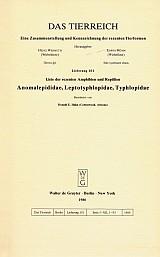




Related bibliographies:
Reptiles
 Snakes Snakes
 Epacrophis Epacrophis
 Epictia Epictia
 Leptotyphlops Leptotyphlops
 Mitophis Mitophis
 Myriopholis Myriopholis
 Namibiana Namibiana
 Rena Rena
 Rhinoguinea Rhinoguinea
 Rhinoleptus Rhinoleptus
 Siagonodon Siagonodon
 Tetracheilostoma Tetracheilostoma
 Tricheilostoma Tricheilostoma
 Trilepida Trilepida
Africa
Asia
Central America
Middle East
North America
South America
West Indies
Indian Ocean






































































































































































































































































































































| |

Bibliography of the family
Leptotyphlopidae (Thread Snakes)

(Reptilia: Serpentes)
Note:
In order to limit redundancy, relevant literature indexed in the related bibliographies in the left column may not have been included in this page. For a comprehensive search of literature, these bibliographies should therefore also be consulted.
 |
Adalsteinnsson, S.A.; Branch, W.R.; Trape, S.; Vitt, L.J.; Hedges, S.B. 2009. Molecular phylogeny, classification, and biogeography of snakes of the family Leptotyphlopidae (Reptilia, Squamata). Zootaxa 2244: 1-50.
Boulenger, G.A. 1893. Catalogue of the snakes in the British Museum (Natural History). Vol. 1. Typhlopidae, Glauconiidae, Boidae, Ilysiidae, Uropeltidae, Xenopeltidae, Colubridae (aglyphae, part). Trustees of the British Museum (Natural History), London. 448 pp.
Broadley, D.G. 1975. The worm snakes (Leptotyphlops) of Africa - a taxonomic challenge. Journal of the Herpetological Association of Africa 13: 10-12.
Broadley, D.G.; Broadley, S. 1999. A review of the African worm snakes from south of latitude 12°S (Serpentes: Leptotyphlopidae). Syntarsus 5: 1-36.
Broadley, D.G.; Watson, G. 1976. A revision of the worm snakes of south eastern Africa (Serpentes: Leptotyphlopidae). Occasional Papers of the National Museums and Monuments of Rhodesia Series B Natural Sciences 5(8): 465-510.
Crow, D.T. 1965. Some of the problems involved in the study of the family Leptotyphlopidae. Journal of the Herpetological Association of Rhodesia 23-24: 50-52.
Das, I.; Wallach, V. 1998. Scolecophidian arboreality revisited. Herpetological Review 29(1): 15-16.
Gehlbach, F.R. 1970. Death-feigning and erratic behaviour in leptotyphlopid, colubrid, and elapid snakes. Herpetologica 26: 24-34.
Gehlbach, F.R.; Watkins, J.F.; Kroll, J.C. 1971. Pheromone trail following studies of typhlopid, leptotyphlopid, and colubrid snakes. Behaviour 40: 282-294.
Hahn, D.E. 1978. A brief review of the genus Leptotyphlops (Reptilia, Serpentes, Leptotyphlopidae) of Asia, with description of a new species. Journal of Herpetology 12(4): 477-489.
Hahn, D.E. 1979. Leptotyphlopidae. Catalogue of American Amphibians and Reptiles 230: 1-4.
Hahn, D.E. 1980. Liste der rezenten Amphibien und Reptilien. Anomalepididae, Leptotyphlopidae, Typhlopidae. Das Tierreich 101: 1-93.
Hoser, R.T. 2012. A review of the extant scolecophidians ("Blindsnakes") including the formal naming and diagnosis of new tribes, genera, subgenera, species and subspecies for divergent taxa. Australasian Journal of Herpetology 15: 1-64.
Jackson, M.K.; Reno, H.W. 1975. Comparative skin structure of some fossorial and subfossorial leptyphlopid and colubrid snakes. Herpetologica 31(3): 350-359.
Klauber, L.M. 1940. The worm snakes of the genus Leptotyphlops in the United States and northern Mexico. Transactions of the San Diego Society of Natural History 9: 87-162.
Kley, N.J. 2001. Prey transport mechanisms in Blindsnakes and the evolution of unilateral feeding systems in snakes. American Zoologist 41(6): 1321-1337.
List, J.C. 1964. The present taxonomic status of the Typhlopidae and Leptotyphlopidae. Journal Ohio Herpetological Society 4: 108.
List, J.C. 1965. Current taxonomic status of the blind snakes, families Typhlopidae and Leptotyphiopidae. Proceedings of the Indiana Academy of Science 74 [1964]: 350-351.
List, J.C. 1966. Comparative osteology of the snake families Typhlopidae and Leptotyphlopidae. Illinois Biol. Monogr. 36: 1-112.
McDowell, S.B. 1968. Osteology of the Typhlopidae and Leptotyphlopidae: a critical review. Copeia 1967: 686-692.
Orejas-Miranda, B.R. 1966. Notas sobre la familia Leptotyphlopidae, 1-2. Comunicaciones Zoologicas del Museo de Historia Natural de Montevideo 9: 1-3.
Orejas-Miranda, B.R. 1968. El genero Leptotyphlops en la region Amazonica. pp. 421-442. In: Lent, H. (ed.). Atas do simposio sobre a biota Amazonica. Conselho National de Pesquisas, Rio de Janeiro.
Orejas-Miranda, B.R.; Zug, G.R.; Garcia, D.Y.E.; Achaval, F. 1977. Scale organs on the head of Leptotyphlops (Reptilia, Serpentes): a variational study. Proceedings of the Biological Society of Washington 90(2): 209-213.
Peters, J.A. 1970. Notes on the hemipenis of several taxa in the family Leptotyphlopidae. Herpetologica 26: 320-324.
Rieppel, O. 1979. The braincase of Typhlops and Leptotyphlops (Reptilia: Serpentes). Zoological Journal of the Linnean Society 65(2): 161-176.
Roux-Estève, R.; Witte, G.F. de 1975. Typhlopidae et Leptotyphlopidae. Exploration Parc Natn. Virunga Deux. Set. 24: 1-61.
Sundersingh, P.P.H. 1960. Reptilian fauna of Pilani with a note on the food contents. Part I. Ophidia. Proceedings Rajasthan Acad. Sci. 7: 52-59.
Vanzolini, P.E. 1970. Climbing habits of Leptotyphlopidae (Serpentes) and Walls's theory of the evolution of the ophidian eye. Papeis Avulsos de Zoologia (São Paulo) 23: 13-16.
Wallach, V. 1993. The supralabial imbrication pattern of the Typhlopoidea (Reptilia: Serpentes). Journal of Herpetology 27(2): 214-218.
Wallach, V. 2003. Leptotyphlopidae: Worm Snakes, not Blind Snakes! Bulletin of the Maryland Herpetological Society 39(2): 21-46.
Wallach, V. 2003. Scolecophidia miscellanea. Hamadryad 27(2): 222-240.
Welch, K.R.G. 1994. Snakes of the world: a checklist. 2: boas, pythons, shield-tails and worm snakes. R & A Research & Information, Taunton. 89 pp.
|
| | 
















































































































































































|

